Marks & Spencer Group Bundle
How Well Do You Know the Marks & Spencer Group Story?
Journey back in time to explore the fascinating M&S history, a true British retail icon. Discover how a simple market stall blossomed into a global powerhouse, shaping consumer habits and retail practices. From its penny bazaar origins to its modern-day presence, the Marks and Spencer Group has a captivating story to tell.
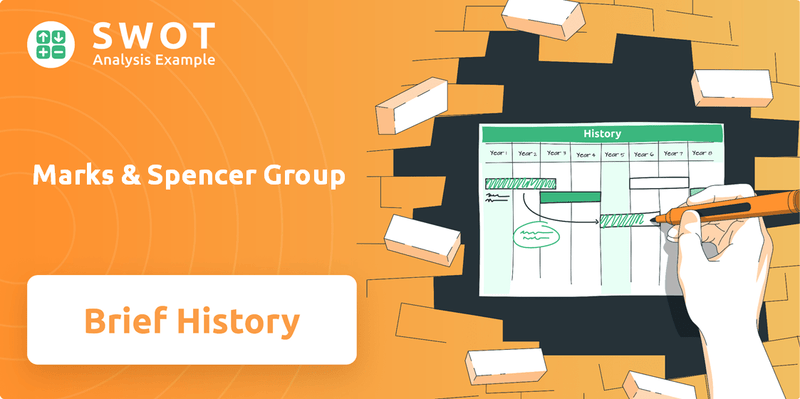
This Marks & Spencer company background reveals a remarkable Company timeline of innovation and adaptation. Understanding the early days of Marks & Spencer and its key milestones provides invaluable insights into the evolution of a British retailer. Explore the history of Marks & Spencer food and fashion, and see how it continues to influence retail history today.
What is the Marks & Spencer Group Founding Story?
The story of Marks & Spencer, a cornerstone of British retail, began in 1884 with Michael Marks and Thomas Spencer. This partnership laid the foundation for a retail empire that would redefine how people shopped. Understanding the early days of Marks & Spencer is crucial to appreciating its lasting impact.
Michael Marks, a Polish Jewish immigrant, started with a 'Penny Bazaar' stall in Leeds. This simple concept, offering affordable goods, quickly gained popularity. The collaboration with Thomas Spencer in 1894 brought financial expertise, solidifying the business's future.
The official formation of 'Marks & Spencer' occurred in 1901, marking the beginning of a retail giant. The company's early success was a response to the needs of a growing urban working class, offering accessible and affordable products.
Michael Marks' 'Penny Bazaar' was the initial concept, offering low-priced goods. Thomas Spencer provided the financial acumen needed for growth. The partnership formalized in 1901, creating the 'Marks & Spencer' we know today.
- Michael Marks, a Polish immigrant, launched the 'Penny Bazaar' in Leeds in 1884.
- Thomas Spencer joined in 1894, bringing financial expertise to the venture.
- The official partnership and name 'Marks & Spencer' began in 1901.
- The business model targeted the growing urban working class with affordable goods.
Michael Marks, with a loan of £5, launched his 'Penny Bazaar' at Kirkgate Market in Leeds. His slogan, 'Don't ask the price, it's a 'Penny',' captured the essence of his value-driven approach. The Marketing Strategy of Marks & Spencer Group has evolved significantly since these early days.
The initial success of the 'Penny Bazaar' demonstrated the demand for affordable goods. The partnership with Thomas Spencer in 1894 was pivotal, ensuring the financial stability needed for expansion. The company's early success was built on providing accessible goods to a growing urban population.
By 1903, the penny bazaar was officially opened at stall numbers 11 and 12, solidifying the brand's presence. This marked the beginning of the company's journey. The early advertising campaigns focused on value and accessibility.
Marks & Spencer Group SWOT Analysis
- Complete SWOT Breakdown
- Fully Customizable
- Editable in Excel & Word
- Professional Formatting
- Investor-Ready Format
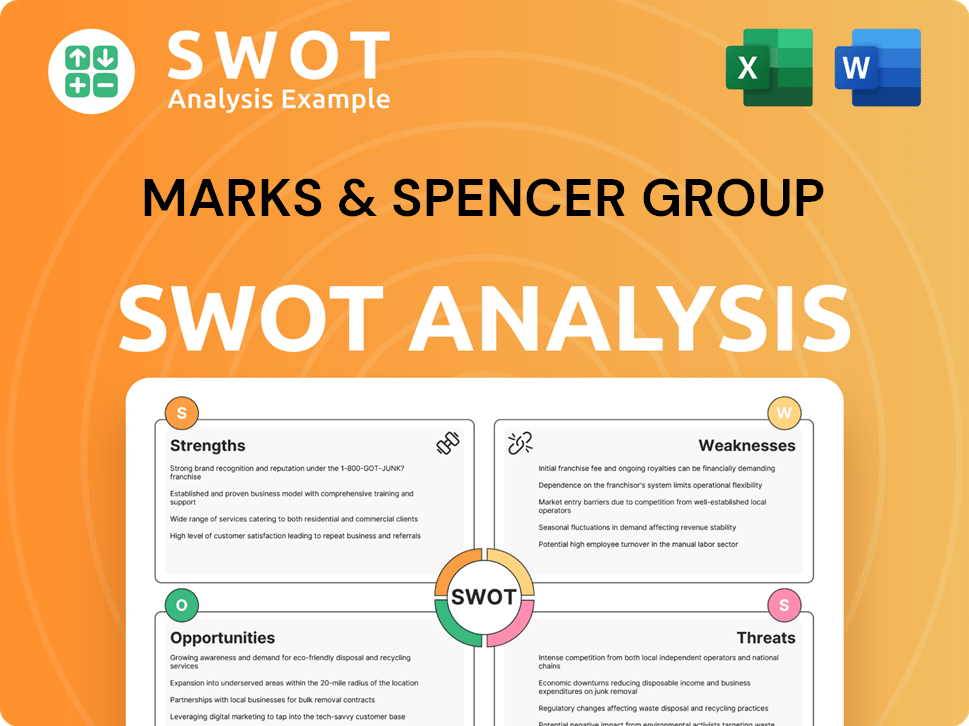
What Drove the Early Growth of Marks & Spencer Group?
The early growth of Marks & Spencer, a prominent British retailer, was marked by its transformation from market stalls into a widespread chain of stores throughout the UK. This expansion built the company's reputation for delivering quality products at reasonable prices. A key decision during this period was to focus exclusively on selling British-made goods, which became a defining characteristic of the Marks and Spencer Group. By the early 20th century, M&S had firmly established its presence in the retail sector.
In response to competitive pressures, M&S has been implementing its 'Reshaping for Growth' strategy, initiated in late 2022. This strategy involves accelerating store rotation and renewal, aiming for approximately 180 full-line stores and over 100 new Food-only stores. The company is also enhancing its online capabilities to boost the share of M&S.com in Fashion, Home & Beauty sales.
For the year ending March 2024, M&S achieved a record revenue of £10.9 billion, reflecting an 8% year-over-year growth. For the 52 weeks ended March 29, 2025, group sales increased by 6.1% to £13.914 billion, with Food sales up 8.7% and Fashion, Home & Beauty sales up 3.5%. The company's adjusted operating profit margin for Fashion, Home & Beauty was 11.2%, and for Food, it was 5.4% for the same period.
M&S plans to open 20 new shops and create thousands of new jobs, focusing on converting former Debenhams sites into full M&S stores. The company aims to increase its food store count from 316 to 420. This expansion is a key part of Marks & Spencer's strategy to strengthen its market position and adapt to the digital age. Check out the Competitors Landscape of Marks & Spencer Group for more context.
M&S is investing in modernizing its supply chain to improve availability and customer service, while also reducing costs. The company is actively enhancing its online capabilities, aiming to increase the M&S.com share of Fashion, Home & Beauty sales from 34% to 50% in the medium term. These investments reflect M&S's commitment to adapting to the evolving retail landscape.
Marks & Spencer Group PESTLE Analysis
- Covers All 6 PESTLE Categories
- No Research Needed – Save Hours of Work
- Built by Experts, Trusted by Consultants
- Instant Download, Ready to Use
- 100% Editable, Fully Customizable
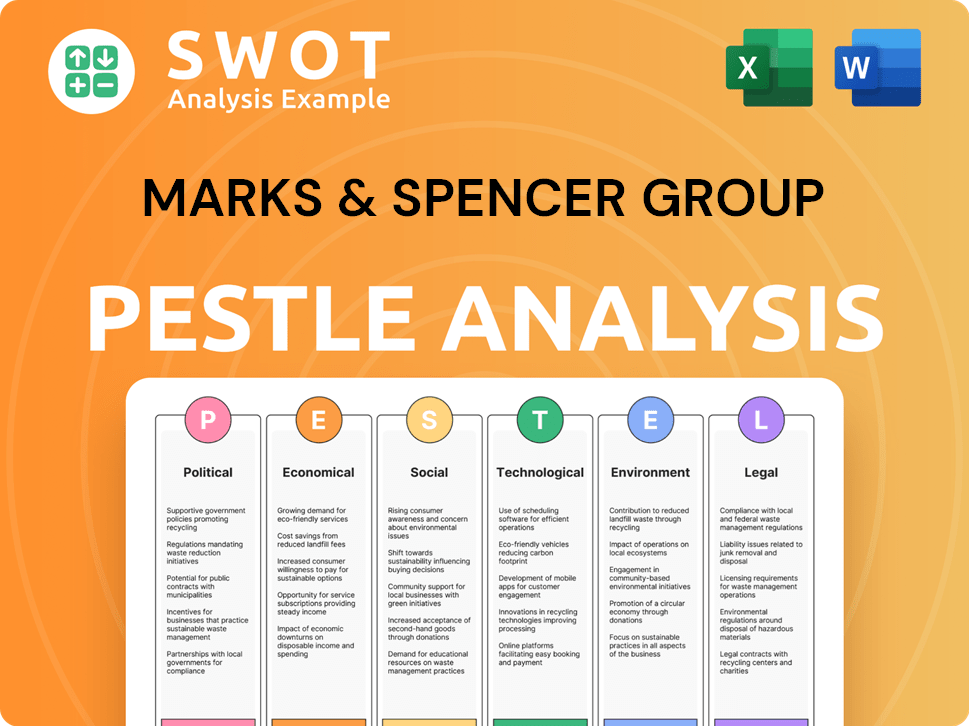
What are the key Milestones in Marks & Spencer Group history?
The Marks & Spencer (M&S) Group has a rich M&S history, marked by significant achievements and periods of intense challenge, evolving from its humble beginnings to a prominent British retailer. The Marks and Spencer Group has consistently adapted to changing market dynamics, making it a key player in retail history.
| Year | Milestone |
|---|---|
| 1884 | Michael Marks starts a market stall in Leeds, laying the foundation for the company. |
| 1894 | Michael Marks partners with Thomas Spencer, leading to the establishment of Marks & Spencer. |
| 1926 | Marks & Spencer becomes a public company. |
| 1980 | M&S introduces packaged sandwiches, a significant innovation in the retail industry. |
| 1998 | Marks & Spencer achieves a pre-tax profit of over £1 billion, a historic milestone. |
| 2007 | The 'Plan A' sustainability initiative is launched, demonstrating a commitment to ethical and environmental practices. |
Throughout its history, Marks & Spencer has been at the forefront of retail innovation. The introduction of packaged sandwiches in 1980 was a pioneering move, setting a new standard in convenience for consumers.
Marks & Spencer was the first British supermarket chain to introduce packaged sandwiches in 1980, revolutionizing the grab-and-go food market.
Launched in 2007, 'Plan A' is a comprehensive sustainability program, updated in 2021, with the goal of achieving net-zero across its entire value chain by 2040.
M&S has invested heavily in digital transformation, including the establishment of Digital Labs and a Data Academy to enhance its online presence and customer engagement.
The company has utilized virtual influencers, like 'Mira,' to connect with younger audiences and promote its products in innovative ways.
M&S has strategically focused on its food business, which has consistently performed well, driving sales and market share growth.
Investment in automation and streamlining operations has improved efficiency and reduced costs, supporting the company's financial performance.
Despite its successes, Marks & Spencer has faced numerous challenges. Market downturns, intense competition from discounters, and shifts in consumer preferences have required strategic adjustments.
M&S has had to navigate economic downturns and increased competition from both traditional and online retailers, impacting its market share.
Adapting to changing consumer tastes, particularly in fashion, has been a continuous challenge, requiring M&S to refresh its product offerings.
M&S has undertaken significant restructuring efforts, including store closures and operational streamlining, to improve efficiency and profitability.
Leadership changes have played a crucial role in guiding the company through challenging periods, with current CEO Stuart Machin focusing on modernization.
The shift towards digital retail has necessitated significant investment in online platforms and supply chain optimization to meet evolving customer expectations.
Global events have caused supply chain disruptions, requiring M&S to diversify its sourcing and improve logistics to maintain product availability.
Marks & Spencer Group Business Model Canvas
- Complete 9-Block Business Model Canvas
- Effortlessly Communicate Your Business Strategy
- Investor-Ready BMC Format
- 100% Editable and Customizable
- Clear and Structured Layout
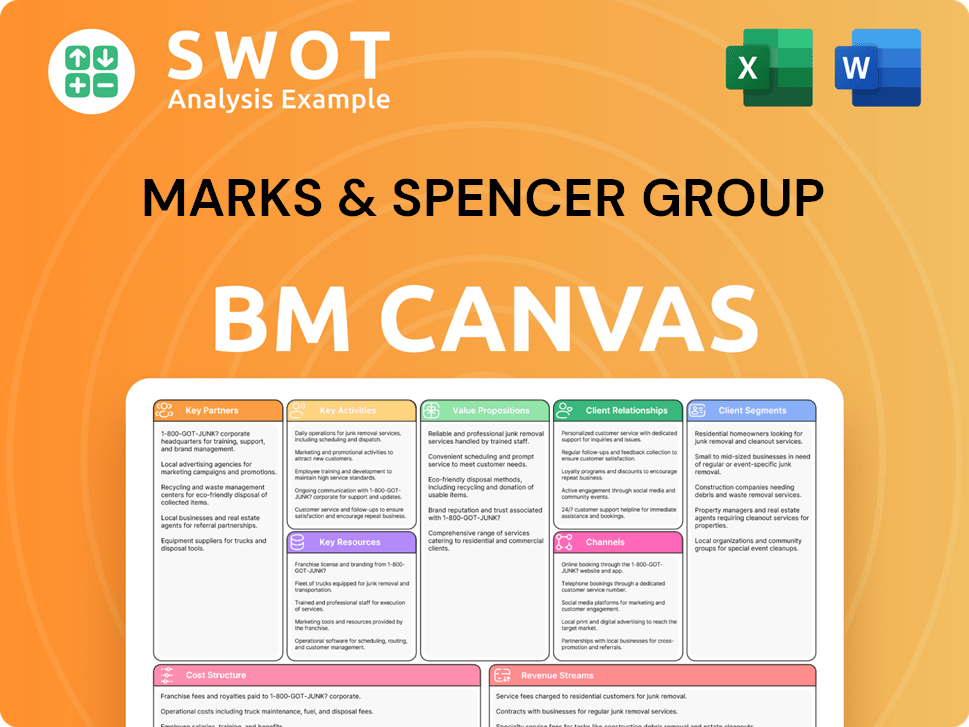
What is the Timeline of Key Events for Marks & Spencer Group?
The Marks & Spencer story, a cornerstone of British retail history, began in 1884 with Michael Marks' Penny Bazaar stall. This marked the early days of Marks & Spencer, evolving into a partnership with Thomas Spencer, and later, the opening of the first official store in 1903. Over the years, Marks and Spencer Group has adapted, from introducing packaged sandwiches in 1980 to becoming a pioneer in sustainability with its 'Plan A' initiative in 2007. The company's commitment to innovation and adapting to changing consumer needs has been a constant throughout its history.
| Year | Key Event |
|---|---|
| 1884 | Michael Marks establishes his 'Penny Bazaar' stall in Kirkgate Market, Leeds. |
| 1894 | Thomas Spencer joins Michael Marks, forming the partnership 'Marks & Spencer.' |
| 1903 | The first Marks & Spencer Penny Bazaar store officially opens. |
| 1980 | M&S becomes the first British supermarket chain to sell packaged sandwiches. |
| 1998 | M&S becomes the first British retailer to make a pre-tax profit of over £1 billion. |
| 2007 | 'Plan A' sustainability initiative is launched. |
| 2008 | The company begins selling branded goods. |
| 2012 | M&S becomes the first carbon-neutral retailer in UK and ROI operations. |
| 2019 | M&S announces a joint venture with Ocado for online food delivery. |
| Late 2022 | The 'Reshaping for Growth' strategy is outlined. |
| 2023 | M&S launches the 'Your M&S' app, enhancing customer engagement. |
| 2024 | M&S introduces new plant-based food products, contributing to a 15% increase in sales in vegetarian and vegan categories. |
| March 2025 | Marks & Spencer reports group sales of £13.914 billion for the 52 weeks ended March 29, 2025, marking a third consecutive year of growth. |
| 2025/26 | M&S targets 100% of packaging to be recyclable and 100% of edible surplus food to be redistributed. |
The 'Reshaping for Growth' strategy focuses on store rotation, supply chain modernization, and enhancing online capabilities. This involves increasing capital investment in 2025/26 to between £600 million - £650 million, with a focus on technology, logistics, and new store openings.
M&S aims to expand its food store count from 316 to 420 and reduce full-line stores to 180 by fiscal year 2028. This strategic shift reflects the company's focus on optimizing its retail footprint and catering to evolving consumer preferences.
The company is targeting for 50% of Fashion, Home & Beauty sales to come from online channels in the medium term. This highlights M&S's commitment to enhancing its digital presence and providing a seamless omnichannel experience for customers.
M&S is committed to achieving net-zero emissions across its value chain by 2040 and reducing carbon emissions by 34% by 2025/26. Key initiatives include sourcing 100% of soy from verified deforestation and conversion-free regions by 2025/26.
Marks & Spencer Group Porter's Five Forces Analysis
- Covers All 5 Competitive Forces in Detail
- Structured for Consultants, Students, and Founders
- 100% Editable in Microsoft Word & Excel
- Instant Digital Download – Use Immediately
- Compatible with Mac & PC – Fully Unlocked
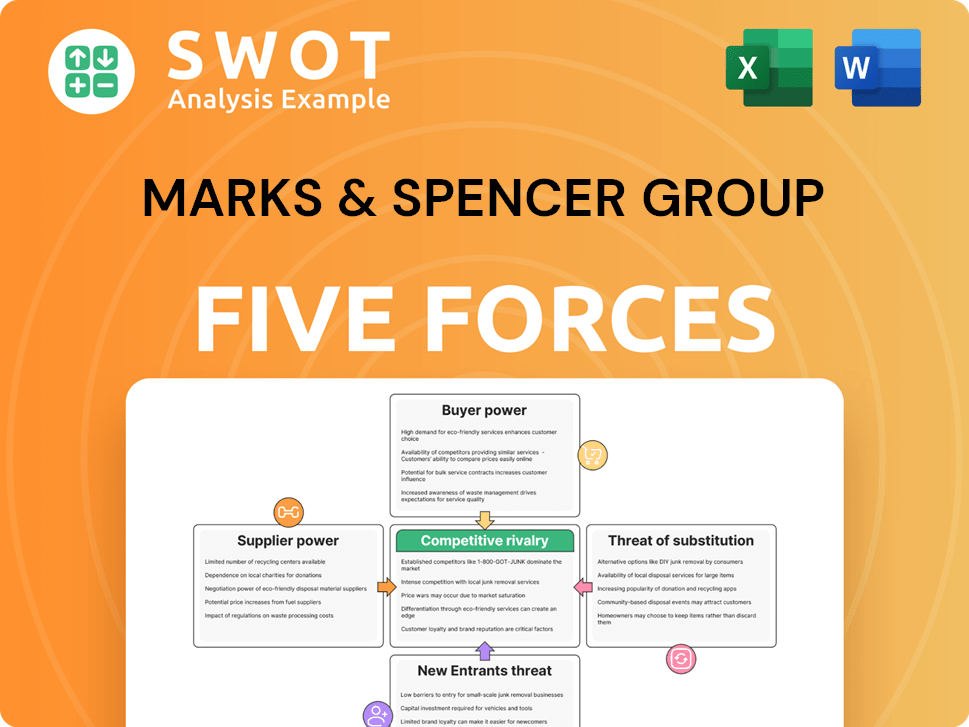
Related Blogs
- What is Competitive Landscape of Marks & Spencer Group Company?
- What is Growth Strategy and Future Prospects of Marks & Spencer Group Company?
- How Does Marks & Spencer Group Company Work?
- What is Sales and Marketing Strategy of Marks & Spencer Group Company?
- What is Brief History of Marks & Spencer Group Company?
- Who Owns Marks & Spencer Group Company?
- What is Customer Demographics and Target Market of Marks & Spencer Group Company?
Disclaimer
All information, articles, and product details provided on this website are for general informational and educational purposes only. We do not claim any ownership over, nor do we intend to infringe upon, any trademarks, copyrights, logos, brand names, or other intellectual property mentioned or depicted on this site. Such intellectual property remains the property of its respective owners, and any references here are made solely for identification or informational purposes, without implying any affiliation, endorsement, or partnership.
We make no representations or warranties, express or implied, regarding the accuracy, completeness, or suitability of any content or products presented. Nothing on this website should be construed as legal, tax, investment, financial, medical, or other professional advice. In addition, no part of this site—including articles or product references—constitutes a solicitation, recommendation, endorsement, advertisement, or offer to buy or sell any securities, franchises, or other financial instruments, particularly in jurisdictions where such activity would be unlawful.
All content is of a general nature and may not address the specific circumstances of any individual or entity. It is not a substitute for professional advice or services. Any actions you take based on the information provided here are strictly at your own risk. You accept full responsibility for any decisions or outcomes arising from your use of this website and agree to release us from any liability in connection with your use of, or reliance upon, the content or products found herein.